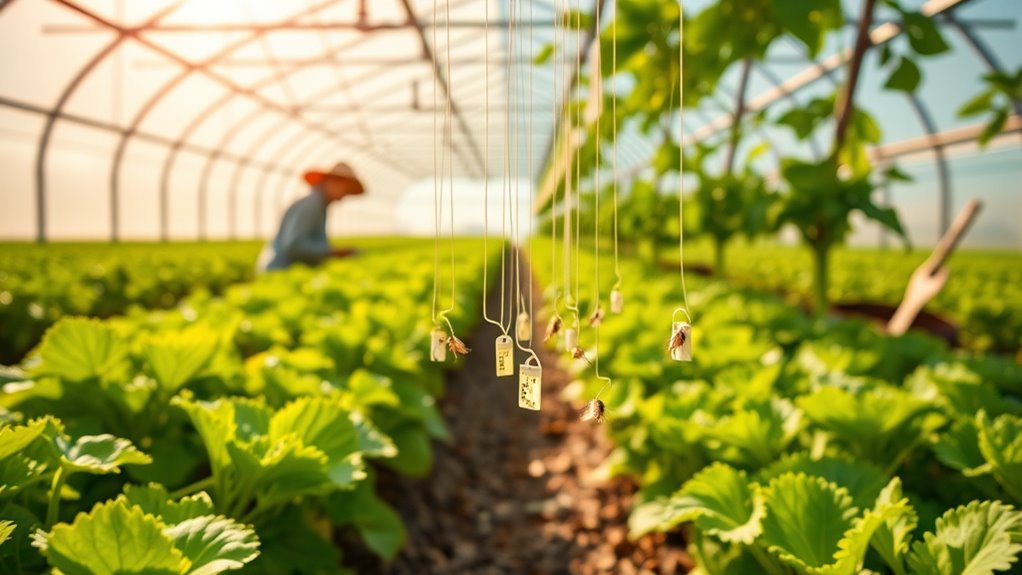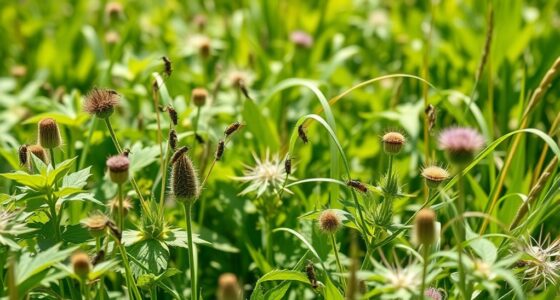To manage pests effectively in high tunnels, focus on regular monitoring to catch problems early and identify pest species and stages. Rotate crops seasonally to break pest cycles and promote soil health. Incorporate integrated practices like sanitation and physical barriers to prevent infestations. Using these cultural methods helps reduce chemical reliance and creates a balanced environment. Keep these strategies in mind—you’ll discover more ways to protect your high tunnel as you continue exploring.
Key Takeaways
- Implement regular pest monitoring to detect early signs of infestation and identify pest species and stages.
- Rotate crops seasonally to interrupt pest life cycles and reduce pest populations naturally.
- Use targeted control measures based on monitoring data to minimize chemical applications and protect beneficial insects.
- Maintain sanitation and physical barriers within the high tunnel to prevent pest entry and reduce habitat for pests.
- Combine pest monitoring and crop rotation as part of an integrated pest management strategy for sustainable control.

High-tunnel cultural practices are essential tools for managing pests and reducing their impact on your crops. When you stay proactive with pest monitoring, you gain valuable insights into pest populations and activity levels within your tunnel. Regular inspections allow you to detect early signs of infestations before they become severe, giving you the chance to act swiftly. Pest monitoring involves systematically checking plants for damage, eggs, larvae, or adult pests, which helps you identify specific pest species and their life stages. This targeted approach enables you to implement appropriate control measures precisely where needed, minimizing chemical use and preserving beneficial insects.
Stay proactive with pest monitoring to detect early infestations and protect your crops effectively.
In addition to vigilant pest monitoring, crop rotation plays a crucial role in disrupting pest life cycles. By changing the types of crops you grow in your high tunnel from season to season, you make it harder for pests to establish and thrive. Many pests are host-specific, meaning they depend on particular plants for food and reproduction. When you rotate crops, you deprive pests of their preferred hosts, reducing their populations naturally. For example, if you grow tomatoes one season, switching to leafy greens or legumes the next can interrupt pest cycles that target tomatoes, like tomato hornworms or whiteflies.
Implementing crop rotation in your high tunnel also benefits your soil health. Different crops draw nutrients differently and can help break disease cycles associated with continuous planting of the same crop. Healthy, diverse soil creates a less hospitable environment for pests and diseases, further protecting your plants. You should plan your crop rotations carefully, considering the pests common to each crop and the compatibility of successive plants. Keep records of what you plant and when, so you can identify patterns and improve your rotation schedule over time.
Incorporating Water Park strategies, such as maintaining proper sanitation and physical barriers, can further reduce pest entry and spread within your high tunnel environment. Combining pest monitoring with strategic crop rotation offers an all-encompassing approach to pest management. Monitoring informs you about pest presence and severity, guiding your decisions on when and where to rotate crops or apply other control methods. When you detect pests early, you can adjust your crop plan accordingly to prevent outbreaks. Over time, these practices help you build a healthier, more resilient high tunnel environment, reducing dependency on chemical controls and promoting sustainable gardening.
Frequently Asked Questions
How Do High-Tunnel Practices Vary for Different Pest Species?
You adapt high-tunnel practices based on the pest species by implementing integrated pest management strategies like crop rotation and sanitation. For soil-borne pests, rotate crops to disrupt their life cycle. For insect pests, use physical barriers like row covers or trap crops. Monitoring pests closely helps you decide when to act, reducing chemical use. Tailoring these practices guarantees effective control while maintaining healthy, productive crops in your high-tunnel environment.
What Are the Economic Benefits of Using Cultural Practices?
Like a wise gardener tending their crops, you’ll find that cultural practices boost your profits through cost savings and yield improvements. By reducing pest damage and minimizing chemical use, you cut expenses and increase harvests. This approach creates a more sustainable, profitable operation, much like a well-tended garden flourishes. Embracing these practices helps you maximize your resources, ensuring a healthier, more productive high-tunnel system that pays off in the long run.
How Do Weather Conditions Influence Pest Management in High Tunnels?
Weather conditions greatly influence pest management in your high tunnels. Temperature fluctuations can either suppress or promote pest migration, making it harder to control infestations. Warmer temperatures may accelerate pest development, while cooler weather can slow their spread. You should monitor weather patterns closely, as sudden changes can lead to unexpected pest activity. Adjust your cultural practices accordingly to effectively manage pests and protect your crops.
Are There Organic Alternatives to Chemical Pest Controls in High Tunnels?
Yes, you can use organic alternatives like companion planting and biological controls in your high tunnels. Companion planting involves growing certain plants together to repel pests naturally and attract beneficial insects. Biological controls include introducing natural predators or beneficial insects to keep pest populations in check. These methods reduce reliance on chemicals, promote a healthy ecosystem, and support sustainable pest management in your high tunnel.
How Can Farmers Monitor Pest Populations Effectively in High Tunnels?
You can effectively monitor pest populations in high tunnels by inspecting plants regularly for signs of pests and damage. Use monitoring techniques like yellow sticky traps to catch flying insects and visual scouting to identify pests early. Keep detailed records of pest activity to spot patterns and determine if populations are increasing. This proactive approach helps you catch infestations early, making it easier to manage pests without relying solely on chemical controls.
Conclusion
By adopting high-tunnel cultural practices, you’re building a fortress against pests, shielding your crops like a knight in shining armor. These methods act as a first line of defense, reducing the need for chemical interventions and promoting healthier plants. Think of it as tending a garden of safety, where each practice is a brick in your pest-proof castle. With consistent effort, you’ll enjoy bountiful harvests and a thriving, pest-resistant oasis.









